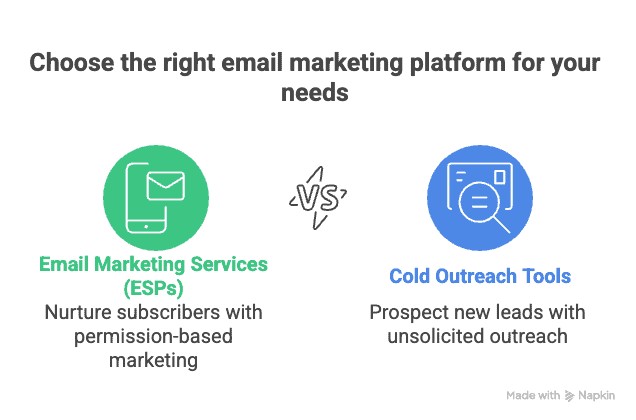There are two very different kinds of email platforms: Email Marketing Services (ESPs) for permission-based newsletters and customer nurturing, and Cold Outreach tools for prospecting people who haven’t opted in. The dividing line is consent. Use each tool for what it’s built to do, and you’ll protect deliverability, stay compliant, and grow faster.
1) ESPs vs. Cold Outreach—What’s the real difference?
ESPs (permission-based): Built to communicate with subscribers/customers who opted in—think newsletters, promos, onboarding and lifecycle automation. Expect drag-and-drop HTML editors, advanced segmentation, journey builders, deep integrations, and revenue reporting.
Cold Outreach (unsolicited): Built to start new conversations with targeted prospects (usually B2B). The stack focuses on deliverability (warm-up, sender rotation, tracking domains) and plain-text, one-to-one style messages to look like a real person, not a blast.
Do not mix them: Using an ESP for cold outreach can violate terms and wreck your domain’s reputation; using a cold tool for newsletters is clunky and underpowered for design/automation at scale.
2) Strategy fit: Nurturing vs. Prospecting
- ESPs = inbound nurturing. Your audience already raised a hand—your job is to educate, retain, and convert over time with helpful content and automations.
- Cold tools = outbound prospecting. You’re creating pipeline proactively; success is about relevant targeting and quick, human replies.
3) Compliance in one glance (US/EU)
- CAN-SPAM (US): Requires accurate headers, honest subject lines, a physical postal address, a clear opt-out link, and honoring opt-outs within 10 business days. Consent isn’t required to send a commercial email, but those rules still apply.
- GDPR (EU): You generally need consent or a defensible legitimate interest (do a balancing test, keep it relevant to the role, and be transparent about source + easy unsubscribe).
4) Success metrics that actually matter
- ESPs: Open rate, CTR, conversions/revenue, list growth & churn.
- Cold tools: Reply rate, positive replies, meetings booked; opens/clicks are secondary health checks.
5) Practical playbook (use this order)
- Clean the list (no purchased emails; validate addresses).
- Authenticate your domain (SPF/DKIM/DMARC).
- Warm up new sending identities; throttle/rotate senders for cold.
- Segment and send only relevant messages; keep cold emails short, plain-text, and personal.
- Monitor bounces, complaints, and unsubscribes; suppress quickly.
6) Recommended ESPs (permission-based marketing)
- Mailchimp — All-in-one and beginner-friendly (email + pages + basic CRM). Free up to 500 contacts/1,000 sends; Essentials from ~$13/mo; Standard from ~$20/mo; Premium ~$350+/mo (pricing scales with contacts).
- Brevo (Sendinblue) — Affordable email + SMS + transactional with a Free 300 emails/day tier; paid plans start low and scale by email volume.
- ActiveCampaign — Best-in-class automations and CRM tie-ins; entry pricing roughly from the mid-teens per month for small lists, scaling with contacts/tiers.
- HubSpot Marketing Hub — Deep CRM + marketing suite; free CRM with limited email; Starter uses “marketing contacts” pricing and auto-tiers as you grow.
Also worth a look for specific needs: Omnisend (e-commerce), GetResponse (webinars), Constant Contact (SMBs/events).
7) Recommended Cold Outreach platforms (unsolicited prospecting)
- Mailshake — Clean cadences, A/B testing, and sales integrations; plans commonly $49–$99/mo tiers.
- Instantly — Scales outreach with unlimited inboxes + warm-up on paid plans; popular for agencies managing volume. (Pricing tiers vary by active contacts/sends.)
- Reply.io — Multichannel (email, calls, SMS, WhatsApp, LinkedIn) with AI assist; priced per user/active contacts with add-ons.
- Lemlist — Stand-out image/video personalization and multichannel sequences (incl. LinkedIn); Email Pro ~$69/mo, Multichannel ~$99/mo.
8) When you have to email non-subscribers (like directory listings)
If you’re announcing “Your business has a free listing,” that’s unsolicited for most recipients. To reduce risk:
- Start small & warm up: send in batches, watch bounce/complaint rates before scaling.
- Use plain text + a real person’s “From”; keep it short and relevant to their business.
- Explain why they’re receiving it (“We added your public business info to our directory”), include a one-click opt-out, and your postal address.
- Route positive replies into your CRM, then move those contacts (now warm) into your ESP for ongoing newsletters with consent.
Tooling tip: Run the first wave via a reputable cold outreach platform (deliverability safeguards), and move engaged replies into your ESP for long-term nurturing. That “hybrid handoff” protects your main domain’s reputation and keeps you within platform policies.
9) Decision cheatsheet
- Use an ESP if the audience opted in and you need polished emails, segments, and automation.
- Use a Cold tool if you’re starting conversations with people who didn’t subscribe, and deliverability is the primary battle.
- Integrate both through your CRM for full-funnel growth.
